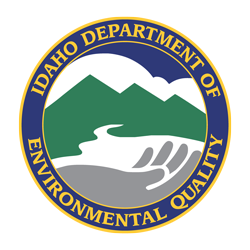Unlike point source pollution that discharges directly from a pipe into surface waters, nonpoint source (NPS) pollution comes from many sources. NPS pollution is caused when precipitation moves over and through surfaces where it picks up pollutants such as fertilizers, grease, and oil, and deposits them into nearby surface waters or groundwater.
There are several common NPS pollutants and sources:
- Chemicals and soaps from driveways and roofs
- Fertilizers and pesticides from agricultural lands and urban areas (e.g., yards, parks, and golf courses)
- Oil, antifreeze, and other toxic materials from roadways
- Sediment from improperly managed construction sites, crop, and forestlands
- Salts from irrigation ponds and drainage from abandoned mines
- Bacteria and nutrients from livestock and pet wastes and faulty septic systems
DEQ’s Nonpoint Source Management Program aims to prevent and eliminate pollution from nonpoint sources by implementing water quality activities prescribed in water body improvement plans known as total maximum daily loads (TMDLs). Activities are designed to protect and restore beneficial uses (such as swimming and fishing) and prevent further water quality degradation.
Nonpoint Source Management Plan
EPA identified nine components necessary for successful state Nonpoint Source Management Plan (NPS) programs. Idaho’s NPS management plan incorporates these objectives and ensures they are incorporated at the local level through the local basin and watershed advisory groups.
- Explicit short- and long-term goals, objectives, and strategies to protect surface and ground water.
- Strong working partnerships and collaboration with appropriate state, tribal, regional, and local entities, private sector groups, citizens’ groups, and federal agencies.
- A balanced approach that emphasizes both statewide nonpoint source programs and on-the-ground management of individual watersheds where waters are impaired or threatened.
- State abatement of known water quality impairments resulting from nonpoint source pollution and prevention of significant threats to water quality from present and future activities.
- Identification of waters and watersheds impaired or threatened by nonpoint source pollution and a process to progressively address these waters.
- State review, upgrade, and implementation of all program components required by §319 of the Clean Water Act and establishment of flexible, targeted, interactive approaches to achieve and maintain beneficial uses of waters as expeditiously as practicable.
- Identification of federal lands and objectives that are not managed consistently with state program objectives.
- Efficient and effective management and implementation of the state’s nonpoint source program, including necessary financial management.
- A feedback loop whereby the state reviews, evaluates and revises its nonpoint source assessment and its management program at least every five years.
Staff Contact
Nonpoint Source (319) Coordinator


